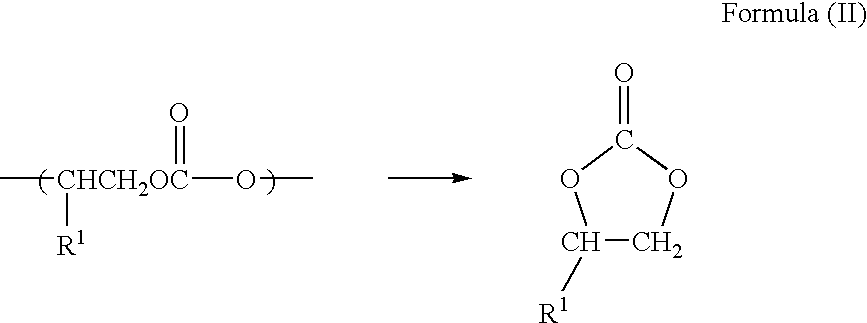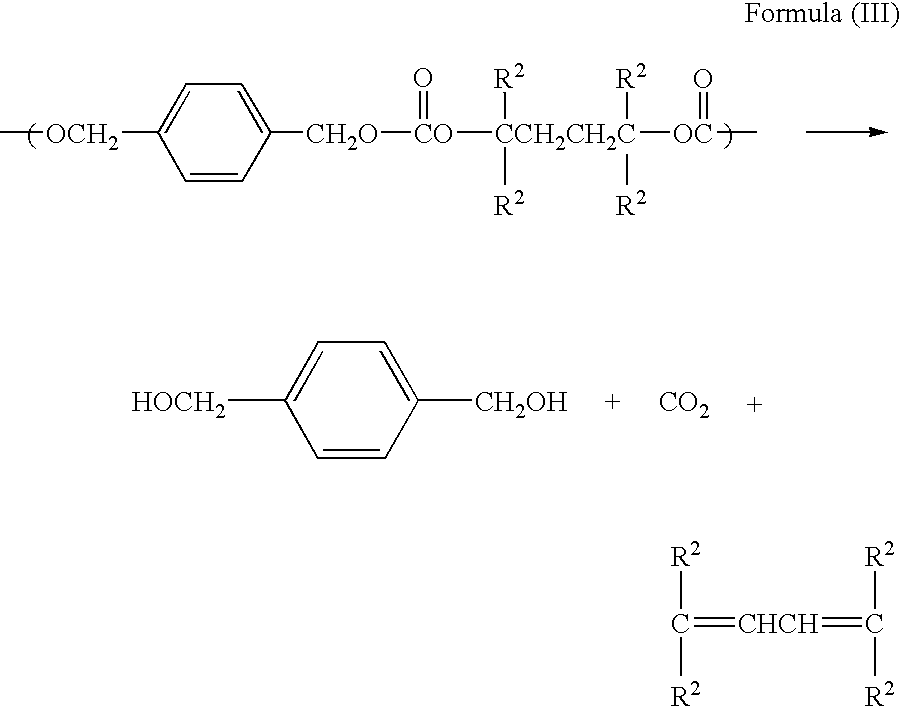Ablatable elements for making flexographic printing plates
a technology of flexographic printing plate and laser engraving, which is applied in the field of laser engraving elements, can solve the problems of poor beam resolution, slow and expensive use, and insufficient power of most imaging devices, and achieve the effect of reducing environmental and health hazards, and being easy to capture and dispose o
- Summary
- Abstract
- Description
- Claims
- Application Information
AI Technical Summary
Benefits of technology
Problems solved by technology
Method used
Image
Examples
example 1
Preparation of Poly(Cyanoacrylate) Laser-Ablatable Element
[0085]A poly(ethoxyethyl-2-cyanoacrylate) solution containing a dispersion of carbon black particles was made as follows:
[0086]A vial was charged with Prism 408 (2.0 g, ethoxyethyl-2-cyanoacrylate), Mogul L carbon black (0.11 g, Cabot Corporation), and dichloromethane (5 g). The dispersion was sonicated using a commercially available horn ultrasonicator and polymerization was initiated by adding 1 drop of a solution of triethylamine (3 drops) in dichloromethane (10 ml). The resulting thick mixture was poured on a coating surface and drawn down with 40 mil (0.1 cm) shim and allowed to air dry overnight to give a smooth laser-ablatable layer on the substrate.
[0087]Pyrolysis GC / MS produced ethoxyethyl-2-cyanoacrylate monomer as the predominant low molecular weight product. Some methoxyethanol was also observed.
example 2
Preparation of Polycarbonate Laser-Ablatable Element
[0088]Poly(propylene carbonate) (2 g, 23,000 molecular weight), obtained from Novomer (Ithaca, N.Y.) was dissolved in dichloromethane (10 g) and mixed with Mogul L carbon black (0.11 g) and a catalyst (0.10 g) of interest (shown in TABLE I below and structures thereafter). The resulting dispersion was sonicated and then evaporated to about 50% solids. The resulting thick mixture was poured onto a coating surface and drawn down with 24 mil (0.06 cm) shim and allowed to air dry overnight to give a smooth laser-ablatable layer on the substrate.
TABLE IExample 2SamplesCatalystStructureANoneB(BP)AlOiPrCzinc glutarateD(BDIEt)ZnOAcE(BDIiPr)ZnOAcFPPNClG(salcy)CoOBzF5
[0089]Propylene carbonate was the predominant low molecular weight product observed by pyrolysis GC / MS. Small amounts of acetone, propanol, allyl alcohol, propylene glycol, and intact ligand from the catalyst were also observed.
[0090]A Comparative Element was prepared similarly ...
example 3
Preparation of Crosslinked Polycarbonate Laser-Ablatable Element
[0092]Poly(propylene carbonate) (2.25 g, 2,300 molecular weight, two hydroxyl end groups) obtained from Novomer (Ithaca, N.Y.) was dissolved in dichloromethane (1.21 g) and mixed with Mogul L carbon black (0.148 g, Cabot Corporation) and Desmodur® N3300 triisocyanate (0.38 g). The dispersion was sonicated and the resulting thick mixture was poured onto a coating surface and allowed to dry to form a crosslinked rubber. A sample added to THF swelled two times its original volume but did not dissolve in the solvent, indicating that crosslinking had occurred.
[0093]The coated sample was successfully imaged with a series of six laser ablation processes, each in a halftone pattern of dots centered on 780 μm spacing. The dot pattern of the six ablations was in a series of increasing dot size beginning at 120 μm and progressing through 210 μm, 300 μm, 390 μm, 480 μm, and 570 μm. The exposure sequence was designed to create a pyr...
PUM
| Property | Measurement | Unit |
|---|---|---|
| thickness | aaaaa | aaaaa |
| weight % | aaaaa | aaaaa |
| thickness | aaaaa | aaaaa |
Abstract
Description
Claims
Application Information
 Login to View More
Login to View More - R&D
- Intellectual Property
- Life Sciences
- Materials
- Tech Scout
- Unparalleled Data Quality
- Higher Quality Content
- 60% Fewer Hallucinations
Browse by: Latest US Patents, China's latest patents, Technical Efficacy Thesaurus, Application Domain, Technology Topic, Popular Technical Reports.
© 2025 PatSnap. All rights reserved.Legal|Privacy policy|Modern Slavery Act Transparency Statement|Sitemap|About US| Contact US: help@patsnap.com



